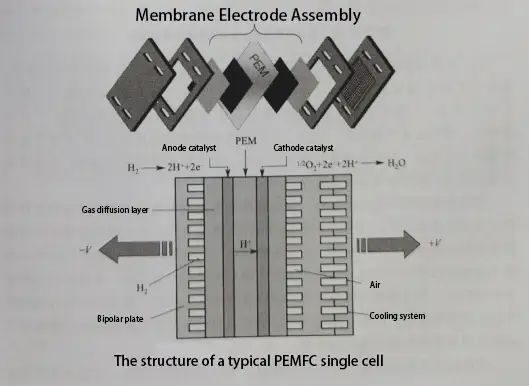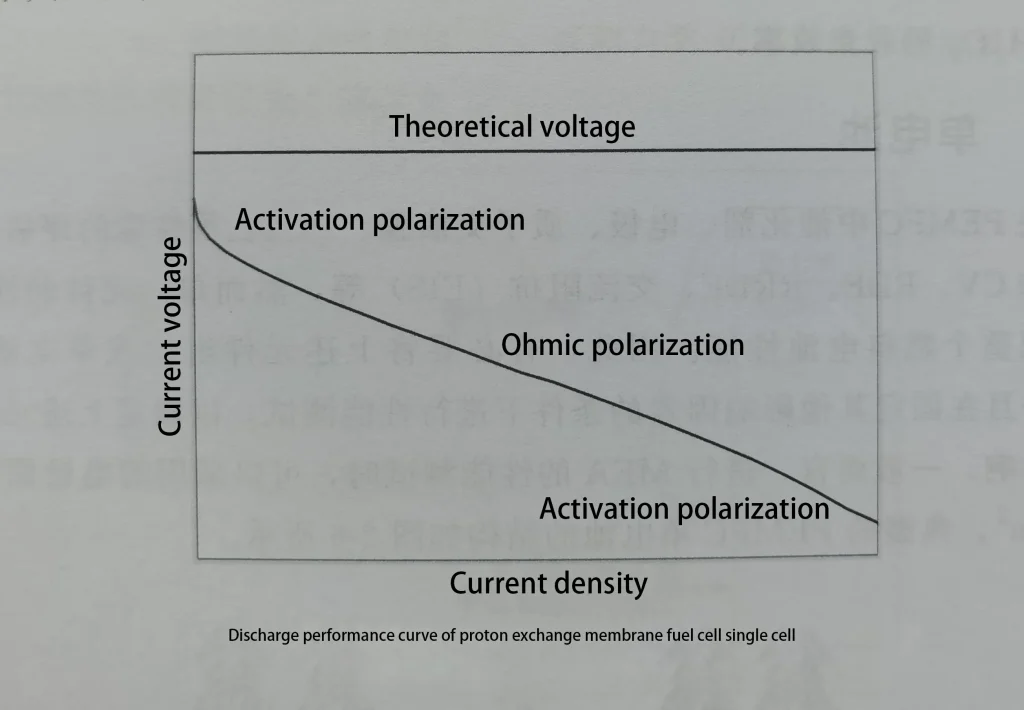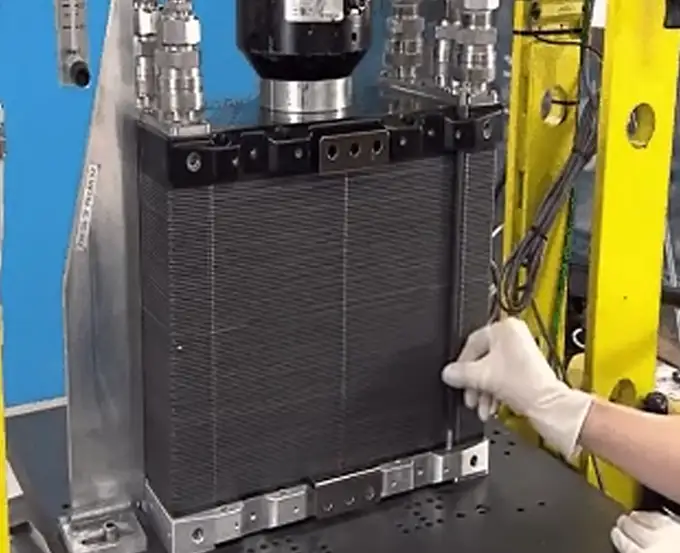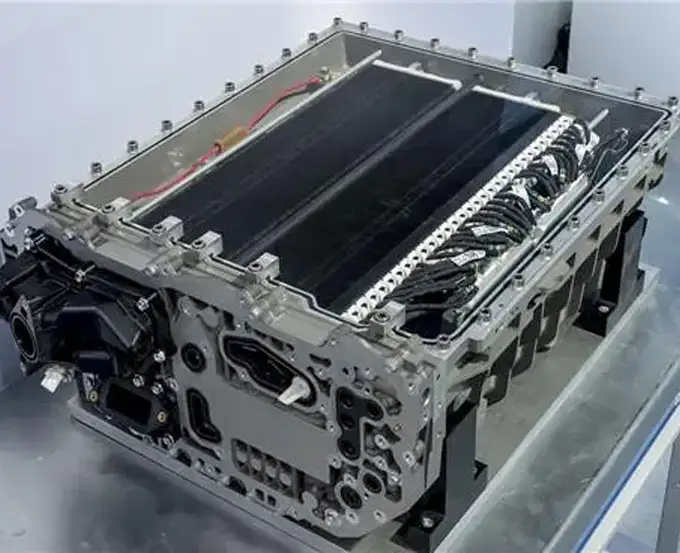Composition and Working Principle of Single Cells
A proton exchange membrane fuel cell (PEMFC) is a type of fuel cell that uses a proton exchange membrane as the electrolyte. The single cell is the fundamental unit that makes up the fuel cell stack. Here are the main components and working principles of a proton exchange membrane fuel cell single cell:
Components:
Bipolar plate,Proton exchange membrane,Gas diffusion layer,Catalyst
Working Principle:
Hydrogen molecules decompose into protons (H⁺) and electrons (e⁻) under the action of the anode catalyst. The electrons (e⁻) flow through an external circuit, generating an electric current, while the protons (H⁺) pass through the proton exchange membrane from the anode to the cathode. At the cathode, oxygen molecules combine with protons and electrons to ultimately produce water.
Performance Testing Methods for Single Cells
In proton exchange membrane fuel cells (PEMFC), there are many methods to evaluate the performance of catalysts, electrodes, proton exchange membranes, and bipolar plates, such as cyclic voltammetry (CV), rotating disk electrode (RDE), rotating ring-disk electrode (RRDE), and electrochemical impedance spectroscopy (EIS). These methods are commonly used to assess the performance of electrocatalysts and other electrode materials.
However, the performance evaluation of individual components (such as catalysts or proton exchange membranes) can only provide partial information about that component and cannot directly reflect the overall performance of the fuel cell. Therefore, it is necessary to combine the above components into a single cell and conduct performance tests under fixed conditions (such as temperature, pressure, and gas flow rates) to determine the impact of these components on the overall performance of the cell. Generally, when conducting performance tests of the membrane electrode assembly (MEA), the electrode area can be reduced to 0.5~5 cm². This size range is small enough for efficient and rapid testing, yet large enough to reflect the actual performance of the MEA.

Electrochemical Reactions and Electrode Potentials
The internal workings of a fuel cell are based on the redox processes of electrochemical reactions. Testing the reaction current and electrode potential is the most direct and effective way to characterize electrochemical reactions. Based on the standard electrode potentials for redox reactions, a larger overpotential indicates an increased additional voltage required for the reaction, which usually means increased resistance. For the cell, an increase in overpotential manifests as a decrease in potential difference, known as the polarization process.
The magnitude of the reaction current reflects the rate at which the electrochemical reaction proceeds. Generally, the larger the current, the faster the reaction; however, excessively high currents may lead to electrode overheating or accelerated aging.
Typically, the output characteristics and power of the cell are of interest, and the actual parameters examined include the cell’s voltage, current density, and power density. The performance of a proton exchange membrane fuel cell is usually evaluated using the cell’s current density-voltage curve (I-V curve) and current density-power density curve (I-P curve). These curves provide detailed information about the cell under different operating conditions. For example, the I-V curve shows the cell’s operating voltage at different current densities, while the I-P curve displays the power output at different current densities.

Analysis of Cell Performance Parameters
The theoretical open-circuit potential of a PEMFC is 1.229V, but the actual open-circuit voltage (OCV) usually does not reach this ideal value, typically ranging from 0.900V to 1.000V. This discrepancy is due to various factors such as hydrogen or oxygen crossover, membrane contamination, and electrode poisoning. Small amounts of hydrogen or oxygen may permeate through the proton exchange membrane to the opposite electrode, creating a mixed potential and lowering the cell’s OCV. Additionally, impurity gases (such as carbon monoxide) can cause electrode poisoning, further affecting cell performance.
By measuring the cell’s OCV, the state of the proton exchange membrane and membrane electrode can be preliminarily evaluated. However, OCV is only one indicator of the overall health of the cell and must be considered alongside other influencing factors. To comprehensively evaluate the performance of a proton exchange membrane fuel cell, it is also necessary to consider the three main voltage losses during the discharge process: activation polarization, ohmic polarization, and mass transport polarization.
Polarization Phenomena and Their Effects
Activation Polarization: Causes and Optimization Methods
Activation polarization, also known as electrochemical polarization, refers to the voltage loss in a proton exchange membrane fuel cell (PEMFC) caused by the speed limitations of the charge transfer process during the electrochemical reactions at the electrodes. This polarization process is particularly pronounced at low current densities. In such cases, the cell voltage decreases rapidly with the increase in reaction current. For example, the voltage drops from the theoretical open-circuit voltage of 1.229V to around 0.8V, though the specific value may vary depending on different systems and conditions.
During cell operation, several methods can optimize the operating conditions to accelerate the kinetics of the electrode reactions, thereby reducing the overpotential associated with activation polarization. These methods include:
Increasing Reaction Temperature: Raising the reaction temperature can accelerate the electrochemical reaction rate, thus reducing activation polarization.
Increasing Reactant Concentration (or Pressure): Enhancing the supply concentration of reactants can speed up the reaction rate and reduce voltage loss.
Using High-Performance Electrocatalysts: Efficient catalysts can lower the activation energy of the reaction, making the electrode reactions faster and more effective.
Increasing the Three-Phase Reaction Zone of the Membrane Electrode: Expanding the contact area between gas, liquid, and solid phases helps the reactants reach the catalyst surface more effectively, improving reaction efficiency.
By employing these methods, the degree of activation polarization can be significantly improved, thereby enhancing the overall performance of the fuel cell.
In cell testing, analyzing the activation polarization region of the cell performance curve (I-V curve) can evaluate the performance of the catalyst and the three-phase reaction zone of the membrane electrode. Voltage changes in the low current density region can reflect the efficiency of the electrocatalyst and the quality of the electrode design. Such analysis can effectively optimize the design and operating conditions of the PEMFC, improving the cell’s performance and efficiency.

The Influence of Ohmic Polarization and Solutions
Ohmic polarization refers to the voltage drop caused by the resistance encountered during the ion and electron transport process within a battery, primarily reflected in the middle part of the battery’s polarization curve. Among these, membrane resistance is the main component of ohmic resistance. Nafion membranes require a certain level of humidity to properly conduct protons, and changes in temperature and humidity can lead to significant differences in proton conductivity. For Nafion-117 membranes, the conductivity at high temperature and high humidity (82°C, 100% humidity) is 400 times that at low temperature and low humidity (24°C, 10% humidity).
Optimizing the proton conductivity of proton exchange membranes, as well as the conductivity and contact resistance of various conductive components within the battery, can help improve the battery’s ohmic polarization process and enhance its actual performance. In recent years, many new types of proton-conducting membranes have been developed, such as polymer membranes containing phosphoric acid (PAE) and other organic-inorganic hybrid membranes, which can provide better performance than Nafion under certain conditions.
In modern PEMFC systems, humidity management is one of the key issues. Using technologies such as gas humidifiers or membrane humidifiers to maintain appropriate membrane humidity is an important research direction. Meanwhile, high-temperature fuel cells (HT-PEMFC) use phosphoric acid-doped proton-conducting membranes, which can operate at temperatures above 100°C, helping to simplify water and thermal management systems.
Through the application of these new materials and technologies, the performance and stability of PEMFCs are expected to be further enhanced, thereby promoting their widespread use in various applications.
The Influence of Mass Transport Polarization and Improvement Measures
Mass transport polarization, also known as concentration polarization, occurs in the latter part of the battery’s polarization curve. The electrocatalytic reactions take place within the membrane electrode, where reactants need to reach the catalyst surface to participate in the reactions, and the products must be expelled from this location. When the reaction rate is sufficiently high, the produced water cannot be expelled in time, and the reactant gases cannot smoothly reach the electrode surface, causing a rapid decrease in the concentration of reactants near the electrode surface, leading to a reduction in battery voltage.
In battery operation, adjusting the flow rate and pressure of the reactant gases can delay the mass transport polarization process. During battery testing, the concentration polarization region of the battery performance curve can also be used to evaluate the battery’s water management. In recent years, researchers have developed various advanced water management techniques, such as optimized gas flow channel designs, the use of hydrophilic/hydrophobic material combinations, and microchannel technology. These techniques effectively improve water management and reduce the impact of mass transport polarization.
Furthermore, improving the structure of the catalyst layer, such as nanoscale catalyst distribution, enhancing the pore structure of the catalyst layer, and optimizing the design of the membrane electrode assembly (MEA), including the catalyst layer, gas diffusion layer (GDL), and bipolar plates, can significantly enhance the transport efficiency of reactants, further reducing mass transport polarization and improving the overall performance of the battery.
With the application of these new technologies and optimization methods, the performance and stability of PEMFCs are expected to be further enhanced, thereby promoting their widespread use in various applications.
Related articles:
Fuel Cells: Performance Testing Methods for Common Electrocatalysts
ORR reaction mechanism of Proton exchange membrane fuel cells
Electrode Reactions in Fuel Cells: Anode and Cathode

